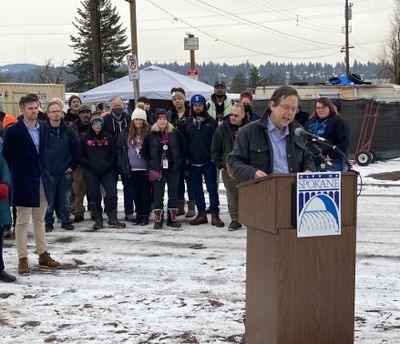With population of Camp Hope dwindling, city leaders look ahead to next steps

As the population at Spokane’s Camp Hope homeless encampment continues to fall, city leaders are eyeing the next steps to rehouse the remaining residents and clear the camp for good.
On Wednesday, Council President Breean Beggs was joined outside of the fence surrounding the camp by Councilman Zack Zappone, Councilwoman Lori Kinnear and representatives of Catholic Charities and Revive Counseling to summarize the work that has been done and the work that remains.
“Some people when they see this encampment, they see a lot of despair and suffering, and they’re fearful and just want it to be gone,” Beggs said. “Other people have looked at this encampment over the last year and see it as an indictment of Spokane that we can’t serve our most vulnerable people.”
“But it doesn’t matter which ‘camp’ you come from in your thinking, it’s about where we’re going,” he added.
From an estimated high of over 600 people living in the encampment this summer, only around 124 remain, according to a report released Wednesday by the state Department of Transportation, which owns the property. The camp is literally shrinking: on Monday, the fencing that surrounds Camp Hope will be moved in by 30 feet, reducing its footprint, officials announced.
While significant progress has been made in recent months to move the camp residents into transitional and permanent housing, the final stretch may be the hardest.
“Some of the more easily placed residents have moved off-site or found other lodging options, while some of those remaining may have multiple challenges or barriers to permanent housing,” WSDOT wrote in a Wednesday press release.
Beggs pointed to three priorities moving forward in order to house those who remain: finding places to relocate RVs, creating a pallet shelter or “tiny home” village and a shelter specifically for those with severe medical needs.
There are 17 RVs remaining at Camp Hope, many of which are not functional, down from 27 in mid-December. Sanctioned areas for those RVs have been considered, including through a proposal favored by the mayor that would use existing camping locations and have the state pay for the lot fees of the homeless people parking RVs there.
When the city presented a plan to the state last summer to rehouse Camp Hope’s residents, it included a funding proposal for a pallet village, said city spokesman Brian Coddington.
“The mayor is sensitive to the concentration of services or resources (into one area), but is open to exploring the right location,” Coddington said.
Existing shelter services are also inadequate for the “medically fragile,” Beggs said.
“Your typical shelter cannot accommodate them,” he added.
While the state has pitched in over $24 million to rehouse and provide services to the residents of Camp Hope, additional funds are necessary to finish the job, Beggs continued.